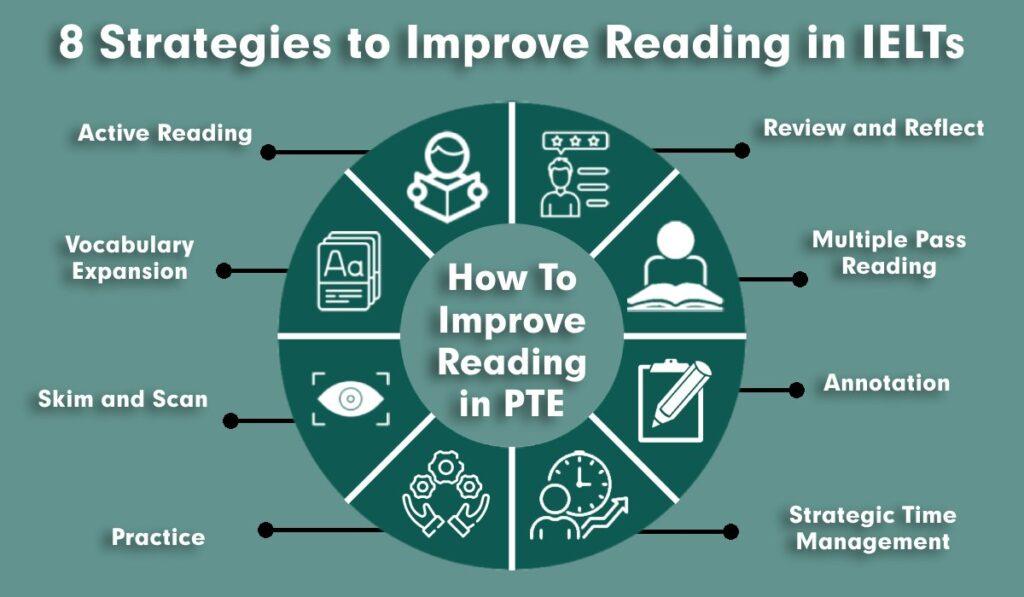How To Improve Reading in PTE

If you’re gearing up to ace the PTE (Pearson Test of English) exam, mastering the reading section and learning how to improve your reading in PTE is crucial. It’s not just about understanding the text; it’s about efficient comprehension and strategic application of skills.
At Centre for Success, we understand the importance of reading proficiency in PTE and are here to share eight methods that can significantly enhance your performance.
Table of Contents
How To Improve Reading in PTE: 8 Strategies

1. Active Reading: Engage Your Brain
The first hack to supercharge your reading skills in PTE is to engage in active reading. This means going beyond just skimming through the text and instead actively interacting with it. How does this work?
When you come across a passage, don’t just read it passively. Instead, actively ask yourself questions about the main idea, key details, and the author’s purpose.
Try to anticipate what information might come next based on what you’ve read so far. This proactive approach keeps your brain engaged and helps improve comprehension.
Why it Works: Active reading forces your brain to actively process information, leading to better retention and understanding of the text. By constantly engaging with the material, you’ll find it easier to answer questions related to the passage in the PTE exam.
How to Implement: Before you begin reading a passage, take a moment to skim through it and formulate some questions in your mind. As you read, try to answer these questions and make connections between different parts of the text.
2. Vocabulary Expansion: Build Your Word Power
A strong vocabulary is your best friend in the reading section of the PTE exam. The more words you know, the easier it becomes to comprehend complex passages and answer related questions accurately.
Why it Works: Building your vocabulary enhances your ability to understand the nuances of the text. It also helps you decipher the meaning of unfamiliar words through context, a skill that is invaluable in the PTE exam.
How to Implement: Make a habit of learning a few new words every day and actively incorporate them into your daily conversations and writing. Additionally, practice using context clues to figure out the meaning of unfamiliar words when you encounter them in reading passages.
3. Skim and Scan: Mastering Quick Reading Techniques
In the fast-paced environment of the PTE exam, mastering the art of skimming and scanning can be a game-changer. Skimming involves quickly glancing through the passage to get a general idea of the content, while scanning involves searching for specific information within the text.
Why it Works: Skimming and scanning save precious time during the exam, allowing you to efficiently locate relevant information without getting bogged down by unnecessary details.
How to Implement: Practice skimming and scanning techniques by setting a timer and challenging yourself to read a passage and answer questions within a strict time limit. Focus on identifying keywords and phrases that are likely to contain the information you need.
4. Practice, Practice, Practice: The Key to Mastery
As with any skill, practice makes perfect when it comes to improving your reading proficiency in PTE. Regular practice not only helps reinforce the strategies mentioned above but also familiarizes you with the format and types of questions you’ll encounter in the exam.
Why it Works: Consistent practice builds confidence and familiarity with the exam format, reducing test anxiety and improving performance on exam day.
How to Implement: Set aside dedicated time each day to practice reading passages and answering related questions. Utilize resources such as practice tests and study guides to simulate exam conditions as closely as possible.
5. Strategic Time Management: Allocate Wisely
Time management is critical in the PTE reading section, where you’re tasked with reading multiple passages and answering questions within a limited timeframe. To maximize your efficiency, allocate your time strategically.
Why it Works: By dividing your time wisely among passages and questions, you ensure that you have enough time to read each passage thoroughly and answer all questions accurately.
How to Implement: Practice time management by setting a strict time limit for each passage and question set during your practice sessions. Learn to prioritize questions based on difficulty and point value, tackling easier ones first to build momentum.
6. Annotation: Mark Your Way to Success
Annotating passages as you read can significantly enhance your understanding and retention of the material. Use symbols, underlines, and marginal notes to highlight key points, main ideas, and important details.
Why it Works: Annotation helps you actively engage with the text, making it easier to recall information and answer questions accurately later on.
How to Implement: Develop a system of symbols and shorthand annotations that work for you, and practice using them consistently while reading passages. Experiment with different techniques, such as circling keywords or drawing arrows to indicate connections between ideas.
7. Multiple Pass Reading: Divide and Conquer
Instead of trying to comprehend the entire passage in one go, consider breaking it down into smaller chunks and reading each part separately. This approach can make complex passages more manageable and improve your overall comprehension.
Why it Works: Reading the passage multiple times allows you to focus on different aspects with each pass, such as understanding the main idea, identifying supporting details, and analyzing the author’s tone and style.
How to Implement: To improve your reading skills for the PTE, divide the passage into sections. Firstly, read each section separately. Then, focus on a specific aspect of comprehension with each pass. For example, on the first pass, focus on understanding the main idea, while on subsequent passes, pay attention to details and authorial intent.
8. Review and Reflect: Learn from Mistakes
After completing practice exercises or mock tests, take the time to review your answers and reflect on any mistakes you made. Identify areas of weakness and make a conscious effort to improve upon them in future practice sessions.
Why it Works: Reviewing your mistakes helps reinforce learning and prevents you from making the same errors in the future. It also allows you to identify patterns and trends in your performance, guiding your study efforts more effectively.
How to Implement: Keep a record of your answers and review them regularly, noting any recurring mistakes or areas where you struggled. Use this information to adjust your study plan and focus on areas that need improvement.
Conclusion:
Mastering the reading section of the PTE exam is within your reach with the right strategies and practice. At Centre for Success, we’re committed to helping you unlock your full potential and achieve success in your PTE journey, and ace the PTE exam. Incorporate these four hacks into your study routine, and watch your reading scores soar.
Get ready to conquer the PTE exam with confidence!
FAQs
Read daily, focusing on both speed and comprehension.
Read academic articles, newspapers, and journals.
Skim the text first, then read the questions and scan for keywords.
Allocate specific time slots for each question type and stick to them.
Yes, skimming for main ideas and scanning for details are effective strategies.





